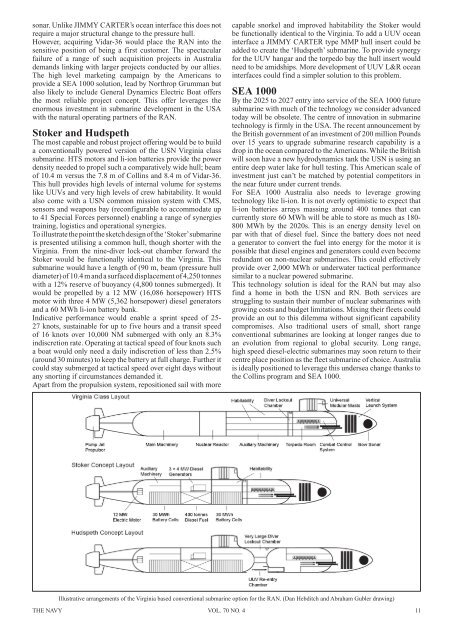The Navy Vol_70_No_4 Oct 2008 - Navy League of Australia
The Navy Vol_70_No_4 Oct 2008 - Navy League of Australia
The Navy Vol_70_No_4 Oct 2008 - Navy League of Australia
You also want an ePaper? Increase the reach of your titles
YUMPU automatically turns print PDFs into web optimized ePapers that Google loves.
sonar. Unlike JIMMY CARTER’s ocean interface this does not<br />
require a major structural change to the pressure hull.<br />
However, acquiring Vidar-36 would place the RAN into the<br />
sensitive position <strong>of</strong> being a first customer. <strong>The</strong> spectacular<br />
failure <strong>of</strong> a range <strong>of</strong> such acquisition projects in <strong>Australia</strong><br />
demands linking with larger projects conducted by our allies.<br />
<strong>The</strong> high level marketing campaign by the Americans to<br />
provide a SEA 1000 solution, lead by <strong>No</strong>rthrop Grumman but<br />
also likely to include General Dynamics Electric Boat <strong>of</strong>fers<br />
the most reliable project concept. This <strong>of</strong>fer leverages the<br />
enormous investment in submarine development in the USA<br />
with the natural operating partners <strong>of</strong> the RAN.<br />
Stoker and Hudspeth<br />
<strong>The</strong> most capable and robust project <strong>of</strong>fering would be to build<br />
a conventionally powered version <strong>of</strong> the USN Virginia class<br />
submarine. HTS motors and li-ion batteries provide the power<br />
density needed to propel such a comparatively wide hull; beam<br />
<strong>of</strong> 10.4 m versus the 7.8 m <strong>of</strong> Collins and 8.4 m <strong>of</strong> Vidar-36.<br />
This hull provides high levels <strong>of</strong> internal volume for systems<br />
like UUVs and very high levels <strong>of</strong> crew habitability. It would<br />
also come with a USN common mission system with CMS,<br />
sensors and weapons bay (reconfigurable to accommodate up<br />
to 41 Special Forces personnel) enabling a range <strong>of</strong> synergies<br />
training, logistics and operational synergies.<br />
To illustrate the point the sketch design <strong>of</strong> the ‘Stoker’ submarine<br />
is presented utilising a common hull, though shorter with the<br />
Virginia. From the nine-diver lock-out chamber forward the<br />
Stoker would be functionally identical to the Virginia. This<br />
submarine would have a length <strong>of</strong> (90 m, beam (pressure hull<br />
diameter) <strong>of</strong> 10.4 m and a surfaced displacement <strong>of</strong> 4,250 tonnes<br />
with a 12% reserve <strong>of</strong> buoyancy (4,800 tonnes submerged). It<br />
would be propelled by a 12 MW (16,086 horsepower) HTS<br />
motor with three 4 MW (5,362 horsepower) diesel generators<br />
and a 60 MWh li-ion battery bank.<br />
Indicative performance would enable a sprint speed <strong>of</strong> 25-<br />
27 knots, sustainable for up to five hours and a transit speed<br />
<strong>of</strong> 16 knots over 10,000 NM submerged with only an 8.3%<br />
indiscretion rate. Operating at tactical speed <strong>of</strong> four knots such<br />
a boat would only need a daily indiscretion <strong>of</strong> less than 2.5%<br />
(around 30 minutes) to keep the battery at full charge. Further it<br />
could stay submerged at tactical speed over eight days without<br />
any snorting if circumstances demanded it.<br />
Apart from the propulsion system, repositioned sail with more<br />
capable snorkel and improved habitability the Stoker would<br />
be functionally identical to the Virginia. To add a UUV ocean<br />
interface a JIMMY CARTER type MMP hull insert could be<br />
added to create the ‘Hudspeth’ submarine. To provide synergy<br />
for the UUV hangar and the torpedo bay the hull insert would<br />
need to be amidships. More development <strong>of</strong> UUV L&R ocean<br />
interfaces could find a simpler solution to this problem.<br />
SEA 1000<br />
By the 2025 to 2027 entry into service <strong>of</strong> the SEA 1000 future<br />
submarine with much <strong>of</strong> the technology we consider advanced<br />
today will be obsolete. <strong>The</strong> centre <strong>of</strong> innovation in submarine<br />
technology is firmly in the USA. <strong>The</strong> recent announcement by<br />
the British government <strong>of</strong> an investment <strong>of</strong> 200 million Pounds<br />
over 15 years to upgrade submarine research capability is a<br />
drop in the ocean compared to the Americans. While the British<br />
will soon have a new hydrodynamics tank the USN is using an<br />
entire deep water lake for hull testing. This American scale <strong>of</strong><br />
investment just can’t be matched by potential competitors in<br />
the near future under current trends.<br />
For SEA 1000 <strong>Australia</strong> also needs to leverage growing<br />
technology like li-ion. It is not overly optimistic to expect that<br />
li-ion batteries arrays massing around 400 tonnes that can<br />
currently store 60 MWh will be able to store as much as 180-<br />
800 MWh by the 2020s. This is an energy density level on<br />
par with that <strong>of</strong> diesel fuel. Since the battery does not need<br />
a generator to convert the fuel into energy for the motor it is<br />
possible that diesel engines and generators could even become<br />
redundant on non-nuclear submarines. This could effectively<br />
provide over 2,000 MWh or underwater tactical performance<br />
similar to a nuclear powered submarine.<br />
This technology solution is ideal for the RAN but may also<br />
find a home in both the USN and RN. Both services are<br />
struggling to sustain their number <strong>of</strong> nuclear submarines with<br />
growing costs and budget limitations. Mixing their fleets could<br />
provide an out to this dilemma without significant capability<br />
compromises. Also traditional users <strong>of</strong> small, short range<br />
conventional submarines are looking at longer ranges due to<br />
an evolution from regional to global security. Long range,<br />
high speed diesel-electric submarines may soon return to their<br />
centre place position as the fleet submarine <strong>of</strong> choice. <strong>Australia</strong><br />
is ideally positioned to leverage this undersea change thanks to<br />
the Collins program and SEA 1000.<br />
Illustrative arrangements <strong>of</strong> the Virginia based conventional submarine option for the RAN. (Dan Hebditch and Abraham Gubler drawing)<br />
THE NAVY VOL. <strong>70</strong> NO. 4 11

















